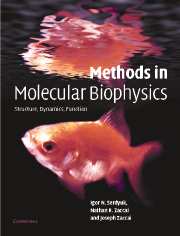Book contents
- Frontmatter
- Contents
- Foreword by D. M. Engelman
- Foreword by Pierre Joliot
- Preface
- Introduction: Molecular biophysics at the beginning of the twenty-first century: from ensemble measurements to single-molecule detection
- Part A Biological macromolecules and physical tools
- Part B Mass spectrometry
- Part C Thermodynamics
- Part D Hydrodynamics
- Chapter D1 Biological macromolecules as hydrodynamic particles
- Chapter D2 Fundamental theory
- Chapter D3 Macromolecular diffusion
- Chapter D4 Analytical ultracentrifugation
- Chapter D5 Electrophoresis
- Chapter D6 Electric birefringence
- Chapter D7 Flow birefringence
- Chapter D8 Fluorescence depolarisation
- Chapter D9 Viscosity
- Chapter D10 Dynamic light scattering
- Chapter D11 Fluorescence correlation spectroscopy
- Part E Optical spectroscopy
- Part F Optical microscopy
- Part G X-ray and neutron diffraction
- Part H Electron diffraction
- Part I Molecular dynamics
- Part J Nuclear magnetic resonance
- References
- Index of eminent scientists
- Subject Index
- References
Chapter D10 - Dynamic light scattering
from Part D - Hydrodynamics
Published online by Cambridge University Press: 05 November 2012
- Frontmatter
- Contents
- Foreword by D. M. Engelman
- Foreword by Pierre Joliot
- Preface
- Introduction: Molecular biophysics at the beginning of the twenty-first century: from ensemble measurements to single-molecule detection
- Part A Biological macromolecules and physical tools
- Part B Mass spectrometry
- Part C Thermodynamics
- Part D Hydrodynamics
- Chapter D1 Biological macromolecules as hydrodynamic particles
- Chapter D2 Fundamental theory
- Chapter D3 Macromolecular diffusion
- Chapter D4 Analytical ultracentrifugation
- Chapter D5 Electrophoresis
- Chapter D6 Electric birefringence
- Chapter D7 Flow birefringence
- Chapter D8 Fluorescence depolarisation
- Chapter D9 Viscosity
- Chapter D10 Dynamic light scattering
- Chapter D11 Fluorescence correlation spectroscopy
- Part E Optical spectroscopy
- Part F Optical microscopy
- Part G X-ray and neutron diffraction
- Part H Electron diffraction
- Part I Molecular dynamics
- Part J Nuclear magnetic resonance
- References
- Index of eminent scientists
- Subject Index
- References
Summary
Historical review
1869
J. Tyndall performed the first experimental studies on light scattering from aerosols. He explained the blue colour of the sky by the presence of dust in the atmosphere.
1871
Lord Rayleigh presented the theory of scattering from assemblies of non-interacting particles that were sufficiently small compared with the wavelength of light. According to Rayleigh, scattering by a gas occurs because of the fluctuation of the molecules around a position of equilibrium. Rayleigh obtained the formulae that explained the blue colour of the sky as being due to preferential scattering of blue light in comparison with red light by molecules in atmosphere.
1906
L. Mandelshtam raised the question on the nature of scattered light once again. He pointed out that Raylegh's arguments do not fully explain the scattering phenomenon. According to Mandelshtam light scattering is also due to the random fluctuations of molecules near the position of equilibrium. As a result of random fluctuations of order λ3, where λ is the scattering wavelength, the number of macromolecules will vary with time. It follows from the Mandelshtam theory that the translational and rotational diffusion coefficients of macromolecules could be obtained from the spectrum of the scattered light.
1924
L. Mandelshtam described theoretically and experimentally so-called combination light scattering, which was later called Raman scattering. As early as 1926 he recognised that the translational diffusion coefficient of macromolecules can be obtained from the spectrum of the light they scatter.
Information
- Type
- Chapter
- Information
- Methods in Molecular BiophysicsStructure, Dynamics, Function, pp. 481 - 504Publisher: Cambridge University PressPrint publication year: 2007
